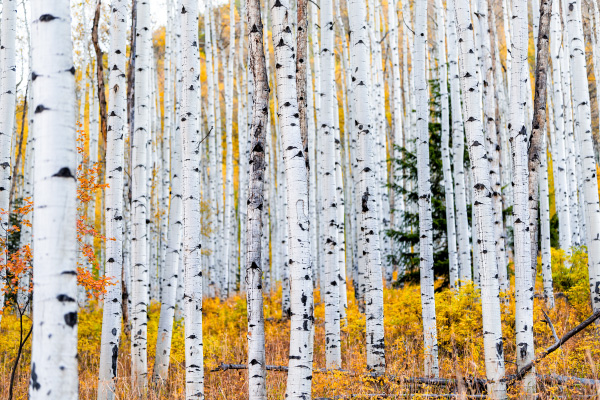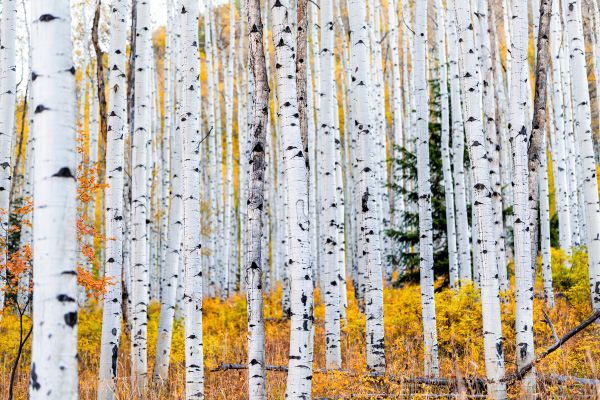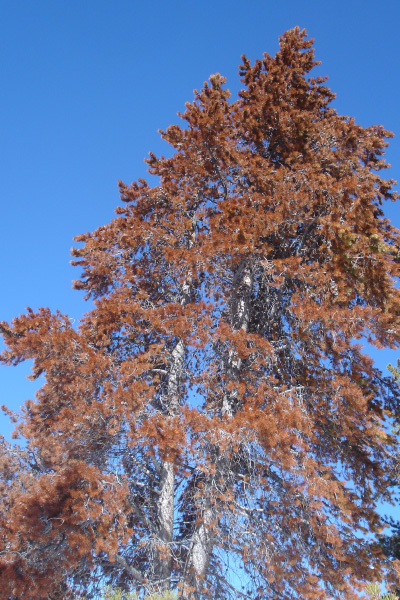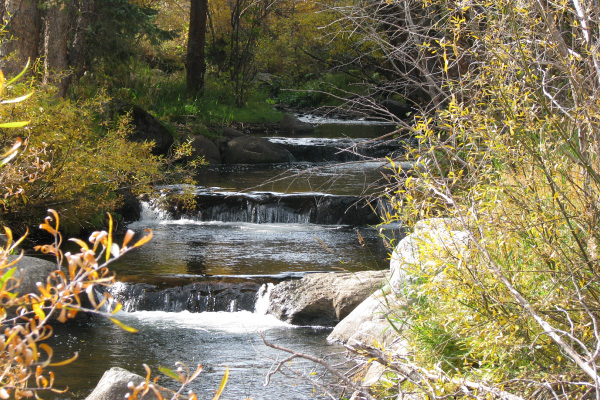El Camino de Edgar
Esta entrevista presenta a Edgar Tellez Soto, Coordinador de Eagle Valley Outdoor Movement (EVOM)...

 Y así comienza. Una mirada curiosa por la ventana no lo recompensará con estallidos de flores púrpuras y azules en los campos. Sin embargo, es posible que vislumbres el amarillo de una hoja que cae y desees una taza de chocolate caliente y una capa extra de ropa.Si ha tenido el placer de pasar un otoño en Colorado, es posible que esté familiarizado con el famoso cambio de color de los álamos. De verde a dorado, este follaje popular marca una época del año que atrae a visitantes de todas partes para experimentar el cambio anual de verano a otoño. Entonces, a medida que damos la bienvenida a los próximos meses y el cambio a principios de octubre con la creciente emoción de Halloween en el aire, también podemos sentir curiosidad por saber cómo y por qué ocurren estos cambios. Pero para comprender verdaderamente la profundidad de este hermoso cambio, es mejor volver a lo básico.
Y así comienza. Una mirada curiosa por la ventana no lo recompensará con estallidos de flores púrpuras y azules en los campos. Sin embargo, es posible que vislumbres el amarillo de una hoja que cae y desees una taza de chocolate caliente y una capa extra de ropa.Si ha tenido el placer de pasar un otoño en Colorado, es posible que esté familiarizado con el famoso cambio de color de los álamos. De verde a dorado, este follaje popular marca una época del año que atrae a visitantes de todas partes para experimentar el cambio anual de verano a otoño. Entonces, a medida que damos la bienvenida a los próximos meses y el cambio a principios de octubre con la creciente emoción de Halloween en el aire, también podemos sentir curiosidad por saber cómo y por qué ocurren estos cambios. Pero para comprender verdaderamente la profundidad de este hermoso cambio, es mejor volver a lo básico. 
A lo largo del año, nuestro planeta gira continuamente alrededor de su eje. El cambio que experimentamos de las cálidas noches de verano a las enérgicas mañanas de otoño se puede atribuir a la inclinación de la Tierra hacia el sol. A medida que giramos sobre nuestro eje, el polo de la Tierra inclinado hacia el sol experimentará temperaturas más cálidas en verano. En el pico de nuestro verano, el hemisferio norte está situado en un camino más directo de la energía del sol. Lo que esto significa es que se dispersa menos luz solar antes de llegar al suelo porque tiene menos distancia para viajar a través de la atmósfera. A medida que la Tierra continúa girando alrededor del sol, ese polo se mueve de modo que apunta en dirección opuesta al sol, lo que reduce la cantidad de luz solar directa que nos llegará. Esto nos lleva a caer (cuando los polos de la Tierra se inclinan hacia los lados con respecto al sol) y, finalmente, al invierno. En el apogeo del otoño, o el equinoccio de otoño, el sol está directamente sobre el ecuador, lo que resulta en horas aproximadamente iguales de luz diurna y nocturna. Esto da como resultado la disminución gradual de la temperatura ... y el inevitable aumento del entusiasmo de nuestros amados entusiastas de la recreación invernal.
Pero mientras revisamos nuestros armarios y nos preparamos para el otoño, sacando gorros y chaquetas de esquí, vale la pena señalar que no todas las especies tienen el lujo de un cambio de vestuario estacional. A medida que las temperaturas comienzan a bajar, un cierto reloj biológico en la vida silvestre también avanza a lo largo del importante paso del tiempo. La mayoría de los animales han evolucionado hacia dos opciones principales para la preparación invernal: adaptación o migración. En el caso de algunos de nuestros amigos emplumados, como el colibrí, migrar hacia el sur hacia regiones más cálidas se ha convertido en el destino de elección. Por otro lado, ciertos mamíferos como la comadreja son capaces de realizar un poco de cambio de vestuario en la preparación para los meses más fríos por delante. Al igual que los hibernadores que saben cuándo es el momento de almacenar grasa durante un largo invierno, los animales que cambian de color tienen un reloj interno que regula el momento de su cambio, lo que les permite saber cuándo y cómo adaptarse a temperaturas más frías. Ya sea que se trate de reservar un boleto para el sur, evaluar el nuevo pelaje de invierno o reunir el festín de su vida, la vida silvestre ha aprendido a cambiar con las estaciones y a abrazarlas con toda su fuerza.
Entonces, cuando se encuentre disfrutando del aire libre esta temporada, tómese un momento para experimentar la caída desde la perspectiva de los demás: el frenético flujo de una ardilla en busca de comida o el lento y constante tropiezo de un oso negro que se prepara para descansar. Cada temporada trae consigo su propia marca particular de belleza. Y si no está seguro de por dónde empezar, considere unirse a una caminata guiada por naturalistas , a las 2 pm en nuestro campus de Avon de lunes a sábado , porque nada es mejor que compartir las estaciones juntos.

Bridget Whyte fue naturalista del Centro de Ciencias Walking Mountains. Cuando era una joven exploradora, disfrutaba de la emoción de los montones de hojas rastrilladas al final del camino de entrada; ahora encuentra emoción en la descomposición de la clorofila .
 And so it begins. A curious look out your window won’t reward you with pops of purple and blue flowers in the fields. However, you may catch glimpses of yellow from a falling leaf and find yourself wishing for a hot cup of cocoa and an extra layer of clothing.
And so it begins. A curious look out your window won’t reward you with pops of purple and blue flowers in the fields. However, you may catch glimpses of yellow from a falling leaf and find yourself wishing for a hot cup of cocoa and an extra layer of clothing.
If you’ve had the pleasure of spending a fall in Colorado, you may be familiar with the famous changing color of the aspen trees. From green to gold, this popular foliage marks a time of year that brings in visitors from all over to experience the yearly shift from summer to fall. So as we welcome the coming months and the shift into early October with the rising excitement of Halloween in the air, we may also find ourselves curious as to how & why these changes occur. But to truly understand the depth of this beautiful change, it’s best to return to the basics.
 Throughout the year, our planet is continually rotating around its axis. The shift we experience from warm summer nights to brisk fall mornings can be attributed to the Earth’s tilt toward the sun. As we rotate on our axis, the pole of the Earth tilted towards the sun will experience warmer temperatures, or summer. At the peak of our summer, the northern hemisphere is situated in a more direct path of the sun's energy. What this means is less sunlight gets scattered before reaching the ground because it has less distance to travel through the atmosphere. As the Earth continues to revolve around the sun, that pole is moved so that it is pointing away from the sun, reducing the amount of direct sunlight that will be hitting us. This brings us around to fall (when the Earth’s poles are tilted sideways with respect to the sun), and eventually, winter. At the height of fall, or the autumnal equinox, the sun is directly above the equator, resulting in approximately equal times of daylight and night. This results in the gradual decrease in temperature… and the inevitable increase in eagerness from our beloved winter recreation enthusiasts.
Throughout the year, our planet is continually rotating around its axis. The shift we experience from warm summer nights to brisk fall mornings can be attributed to the Earth’s tilt toward the sun. As we rotate on our axis, the pole of the Earth tilted towards the sun will experience warmer temperatures, or summer. At the peak of our summer, the northern hemisphere is situated in a more direct path of the sun's energy. What this means is less sunlight gets scattered before reaching the ground because it has less distance to travel through the atmosphere. As the Earth continues to revolve around the sun, that pole is moved so that it is pointing away from the sun, reducing the amount of direct sunlight that will be hitting us. This brings us around to fall (when the Earth’s poles are tilted sideways with respect to the sun), and eventually, winter. At the height of fall, or the autumnal equinox, the sun is directly above the equator, resulting in approximately equal times of daylight and night. This results in the gradual decrease in temperature… and the inevitable increase in eagerness from our beloved winter recreation enthusiasts.
But as we sort through our closets and prepare for fall, pulling out beanies and ski jackets, it’s worth noting that not all species have the luxury of a seasonal wardrobe change. As temperatures begin lowering, a certain biological clock in wildlife ticks along the important passing of time, as well. Most animals have evolved towards two major options for winter preparation: adaptation or migration. In the case of some of our feathered friends, like the hummingbird, migrating south towards warmer regions has become the destination of choice. On the other hand, certain mammals like the weasel are able to perform a bit of a costume change in preparation for the colder months ahead. Just like hibernators that know when it’s time to store up fat for a long winter, animals that switch colors have an internal clock that regulates the timing of their change, allowing them to know just when and how to adapt to colder temperatures. Whether it’s booking a ticket south, sizing up the new winter fur, or gathering a feast of a lifetime, wildlife have learned to change with the seasons and embrace them in all their force.
So, when you find yourself enjoying the outdoors this season, take a moment to experience fall from the perspective of others: the frantic flow of a squirrel searching for food, or the slow and steady stumble of a black bear gearing up for rest. Each season brings with it its own particular brand of beauty. And if you’re unsure of where to start, consider joining along for a Naturalist Guided Walk — 2pm at our Avon Campus Monday through Saturday — because nothing beats sharing the seasons together. 
Bridget Whyte was a Naturalist for Walking Mountains Science Center. As a young explorer, she enjoyed the thrills of raked leaf piles at the end of the driveway; now she finds excitement in the breakdown of chlorophyll .

Esta entrevista presenta a Edgar Tellez Soto, Coordinador de Eagle Valley Outdoor Movement (EVOM)...

Los muros están en todas partes. Pero lo que significan depende de ti. Los muros pueden ser...